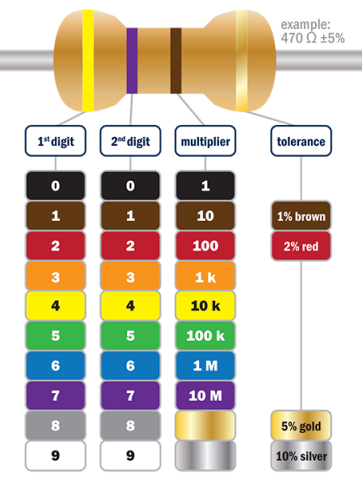Resistor Color Codes
Resistors resist the flow of electrical current. Each one has a value that tells how strongly it resists current flow. This value’s unit is the ohm, often noted with the Greek letter omega: Ω.
The colored bands on a resistor can tell you everything you need to know about its value and tolerance, as long as you understand how to read them. The order in which the colors are arranged is very important, and each value of resistor has its own unique combination.

Here is an example that shows how the table and resistor shown above can be used to figure out a resistor value by proving that yellow-violet-brown is really 470 Ω:
- The first stripe is yellow, which means the leftmost digit is a 4.
- The second stripe is violet, which means the next digit is a 7.
- The third stripe is brown. Since brown is 1, it means add one zero to the right of the first two digits.
Yellow-Violet-Brown = 4-7-0 = 470 Ω.
Although the first two bands are fairly straightforward, the third and fourth bands might require a bit more explanation.
Multiplier Band
Resistor values can get to be very high in number, and there often isn’t enough space to use a band for every digit. To get around this, the third band indicates that a certain number of zeros should be added after the first two digits to make up the full resistor value. In the example above, the third stripe is brown, indicating that a single zero should be added to the right of the first two digits.
If you want to go deeper into the math, this third band is officially referred to as a multiplier. The color of the band determines the power of 10 you need to multiply the first two resistor digits by. For example an orange third band with a digit value of 3 would indicate a multiplier of 103, though you can also just think of this as telling you to “stick 3 zeros on the end”.
Example:
- Brown-black-orange resistor.
- Brown = 1, black = 0, orange multiplier = 103
- 10 x 103 = 10000, which is the same as 10 + three zeros = 10000.
Notice that however you decide to think about it, the result ends up being the same.
Tolerance Band
The fourth color band indicates the resistor’s tolerance. Tolerance is the percentage of error in the resistor’s resistance, or how much more or less you can expect a resistor’s actual measured resistance to be from its stated resistance. A gold tolerance band is 5% tolerance, silver is 10%, and no band at all would mean a 20% tolerance.
For example:
- A 220 Ω resistor has a silver tolerance band.
- Tolerance = value of resistor x value of tolerance band = 220 Ω x 10% = 22 Ω
- 220 Ω stated resistance +/- 22 Ω tolerance means that the resistor could range in actual value from as much as 242 Ω to as little as 198 Ω.
Some projects require your measurements to be more precise than others, and for this reason the tolerance band is useful in identifying which resistor will give you a more accurate resistance reading. The smaller the tolerance percentage is, the higher the precision in your measurements.
